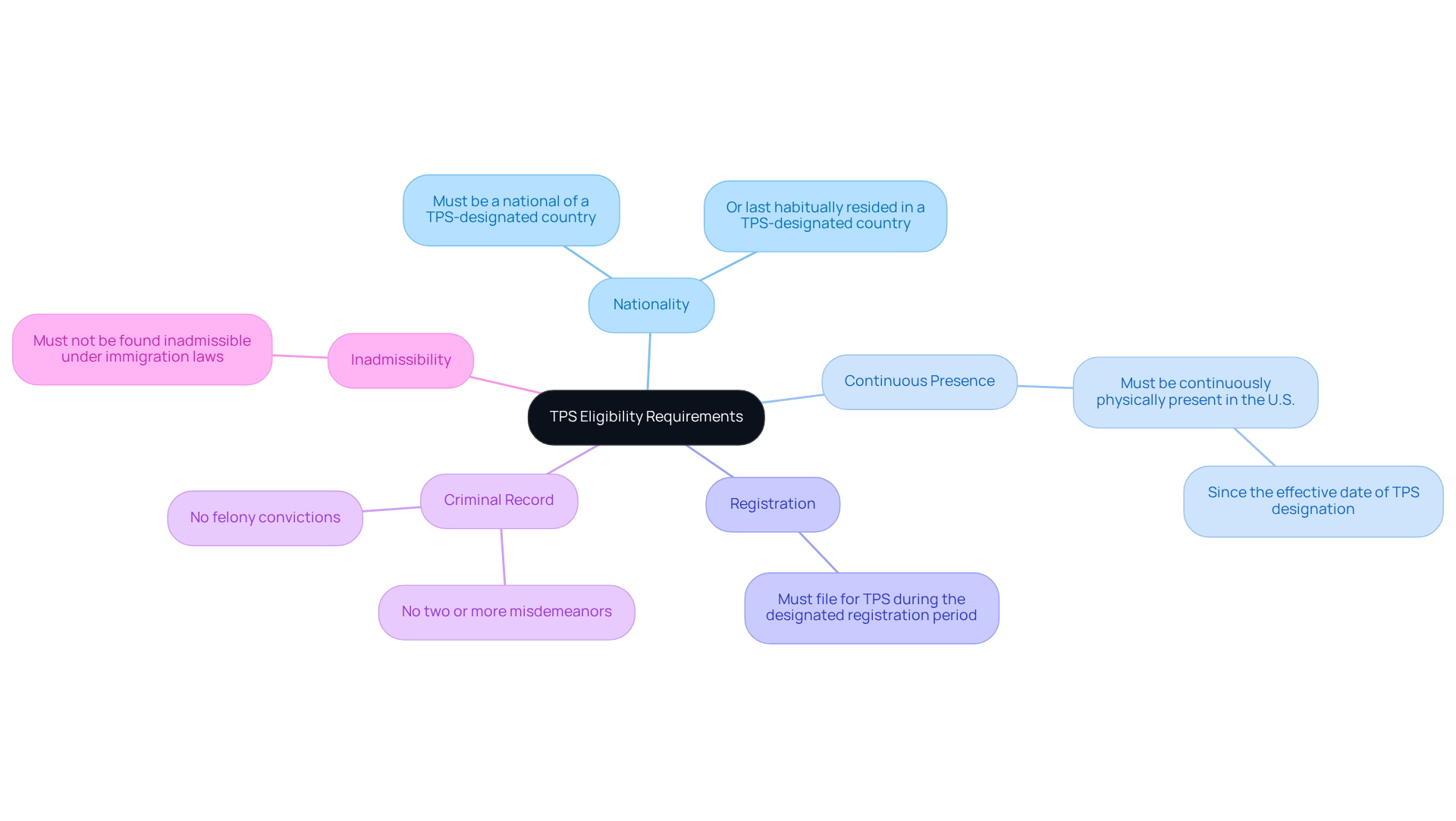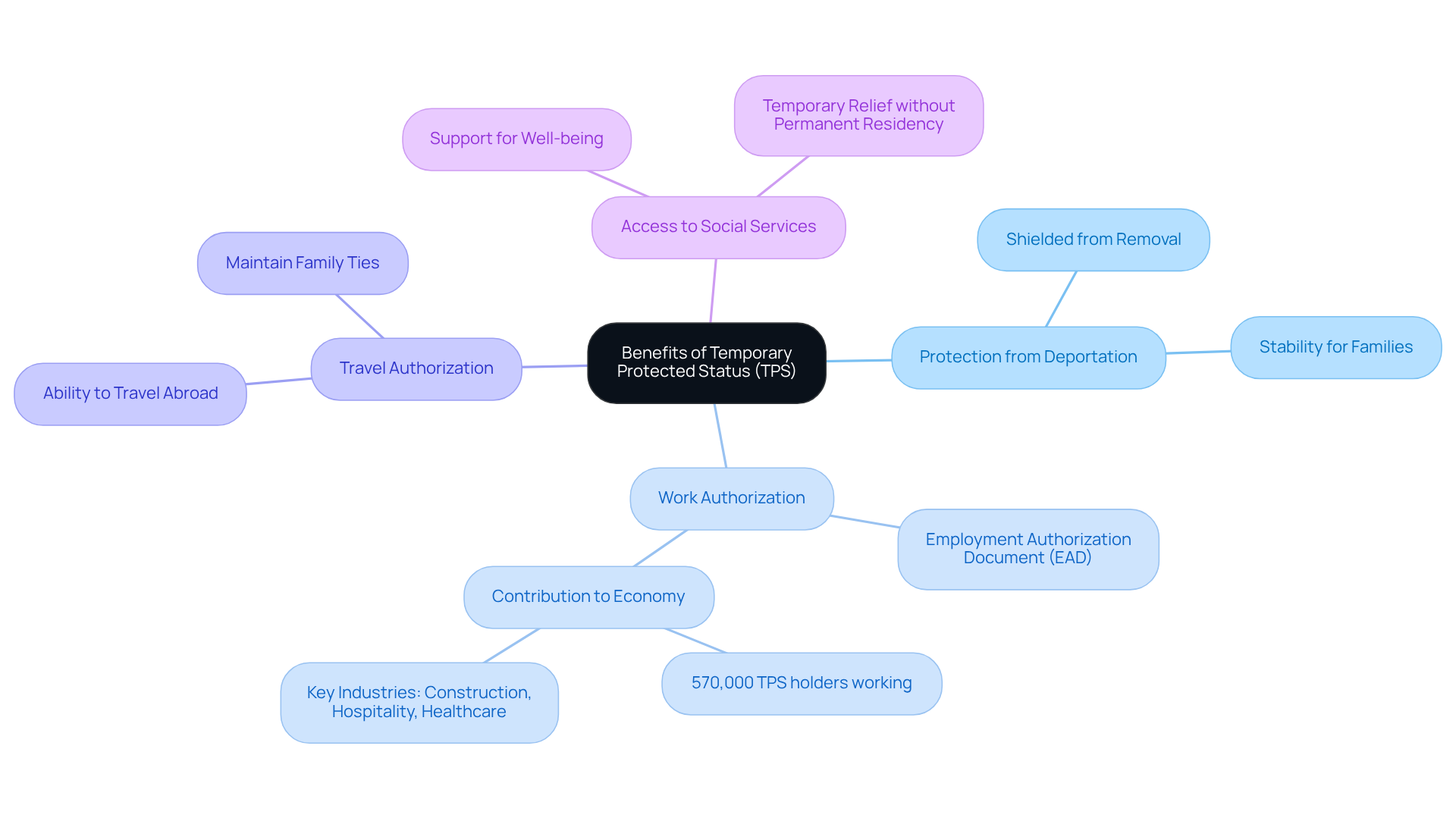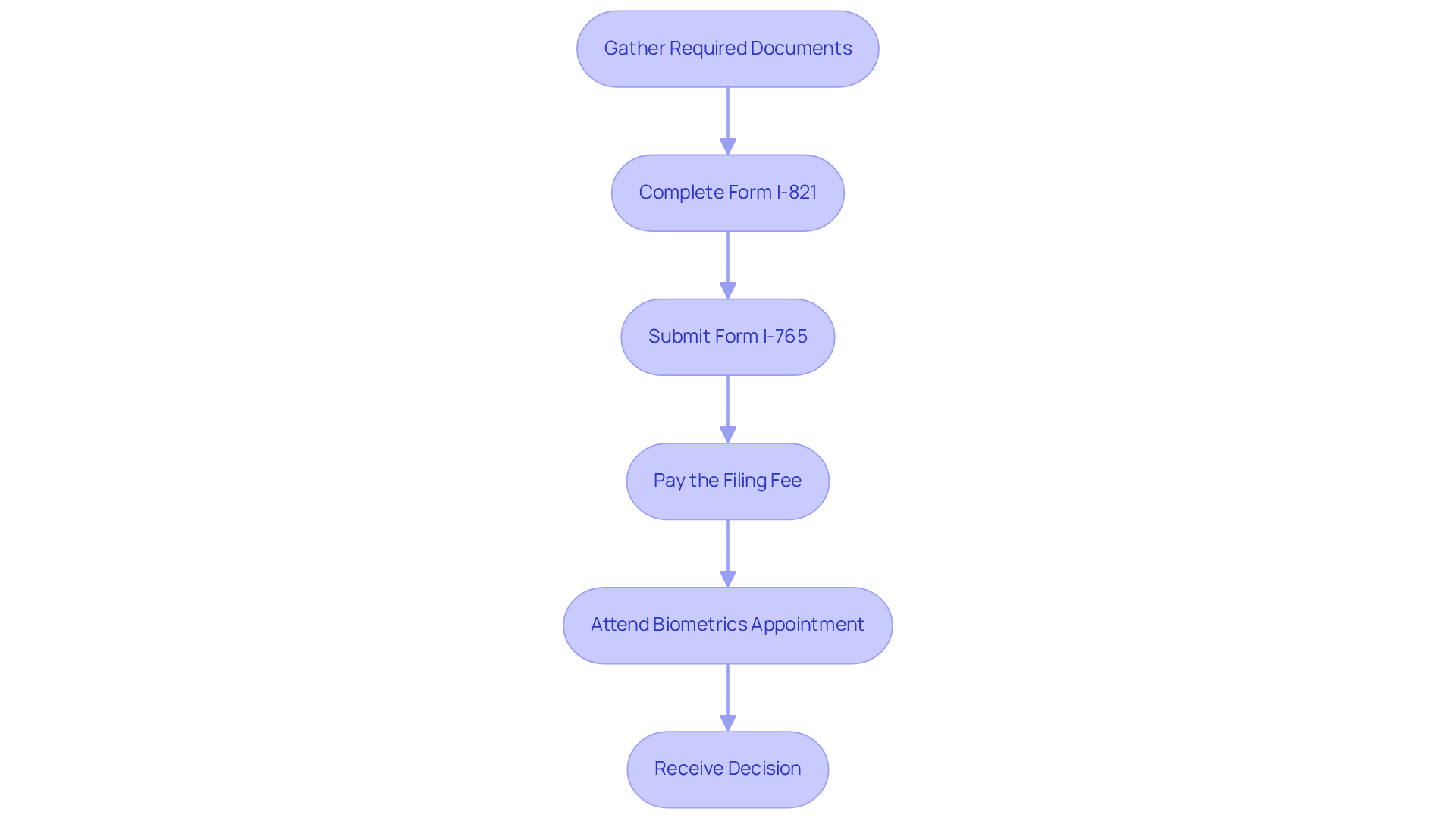Introduction
Navigating the complexities of immigration can feel overwhelming, especially for those fleeing turmoil in their home countries. Temporary Protected Status (TPS) stands as a vital lifeline for individuals from nations facing armed conflict or natural disasters, granting them the opportunity to live and work safely in the United States. This article explores the eligibility requirements, benefits, and application process for TPS, shedding light on the paths available for those seeking protection. But what happens when the very safety net designed to support them becomes a source of confusion and uncertainty?
Have you ever felt lost in the immigration process? You’re not alone. Many face the daunting task of understanding TPS, and that’s where we come in. We’re here to fight for your family, ensuring you have the clarity you need to navigate these challenges. Your future matters to us, and we’ll guide you every step of the way.
Define Temporary Protected Status (TPS)
Immigration TPS, or Temporary Protected Status, is a vital humanitarian initiative from the U.S. government, designed to support individuals from specific nations facing ongoing armed conflict, environmental disasters, or other extraordinary circumstances. As of 2025, immigration TPS is available for nationals from several countries, including:
- El Salvador
- Honduras
- Haiti
- Nepal
- Nicaragua
- Sudan
This program, known as immigration TPS, allows eligible individuals to live and work in the United States temporarily, providing essential protections against deportation and the opportunity to secure work authorization while their home countries remain unsafe.
While immigration TPS doesn’t grant permanent residency, it plays a crucial role in protecting the rights and livelihoods of its recipients. For instance, TPS holders cannot be removed from the country and cannot be detained by the Department of Homeland Security (DHS) solely based on their immigration status. They are also eligible for an Employment Authorization Document (EAD) and can apply for travel authorization during their TPS designation.
Recent updates show that the Biden administration has reversed the Trump-era terminations of immigration TPS, which allows many individuals to keep their protections while legal challenges unfold. This decision reflects a broader commitment to supporting beneficiaries of immigration TPS, who significantly contribute to the American economy. Long-term TPS beneficiaries from El Salvador and Honduras, for example, have labor force participation rates between 81% and 88%, surpassing the overall rate of 63% in the United States.
Real-life stories highlight the impact of TPS on families and communities. Take Wilna, a Haitian TPS recipient and community leader in Florida. She actively advocates for immigration relief, shedding light on the challenges TPS recipients face and their valuable contributions to society. Moreover, TPS holders collectively contribute around $21 billion annually to the U.S. economy, underscoring their essential role across various sectors.
In summary, immigration TPS is a crucial lifeline for individuals from designated countries, offering them the chance to rebuild their lives in a safe environment while promoting their rights and pursuing pathways to permanent residency. We’re here to fight for your family and ensure your future matters.

Outline Eligibility Requirements for TPS
To qualify for Temporary Protected Status (TPS), applicants must meet several key criteria:
- Nationality: You need to be a national of a country designated for TPS or someone without nationality who last habitually resided in a TPS-designated country.
- Continuous Presence: You must have been continuously physically present in the United States since the effective date of the TPS designation for your country.
- Registration: It’s crucial to file for TPS during the designated registration period to maintain your eligibility.
- Criminal Record: If you’ve been convicted of any felony or two or more misdemeanors, you won’t qualify for TPS.
- Inadmissibility: You must not be found inadmissible under specific immigration laws, ensuring you meet the necessary legal standards.
We understand how overwhelming this situation regarding immigration TPS feels. It’s essential for applicants of immigration TPS to know their rights, including the right to remain silent and the right to an attorney. If you face immigration enforcement or criminal charges, immediate action is vital. If you receive a subpoena or find yourself in an urgent legal situation, reach out to Vasquez Law Firm. We’re here for you, providing personalized legal representation across North Carolina and Florida, available 24/7 to ensure you know your rights and have direct access to an attorney who can guide you through these critical moments.
Recent data shows that many applicants for immigration TPS successfully meet these eligibility criteria. Numerous beneficiaries of immigration TPS have established their lives in America, contributing to their communities and economies. This highlights the role of immigration TPS in providing stability for individuals from countries facing perilous situations. At Vasquez Law Firm, we also operate on a contingency fee basis for personal injury cases—meaning you pay nothing unless we win. This ensures that financial constraints never prevent you from seeking the justice you deserve.
Your future matters to us. We’re here to fight for your family. Yo Peleo — We Fight.

Explore Benefits of TPS
Temporary Protected Status (TPS) offers vital benefits for eligible immigrants, significantly impacting their lives in the U.S. Here’s how:
-
Protection from Deportation: TPS recipients are shielded from being expelled during the designated TPS period. This means they can live here without the constant worry of removal.
-
Work Authorization: With TPS, individuals can apply for an Employment Authorization Document (EAD), granting them the legal right to work in the United States. As of 2025, around 570,000 individuals benefiting from immigration TPS are actively contributing to various sectors like construction, hospitality, and healthcare. This is part of a larger group of over a million immigration TPS holders in America, highlighting their essential role in our economy.
-
Travel Authorization: TPS beneficiaries may qualify to travel abroad and return, as long as they obtain the necessary travel documents. This flexibility is crucial for maintaining family ties and addressing personal matters.
-
Access to Social Services: While TPS doesn’t lead to permanent residency, it allows individuals to access specific social services and benefits during their stay, which can be vital for their well-being and stability.
Consider the story of Evelyn, a TPS recipient from El Salvador. She’s lived in the U.S. for over thirty years and actively advocates for immigrant rights. Her experience shows how TPS enables individuals to contribute positively to their communities. Many TPS beneficiaries have built families here, with over 260,000 citizen children and more than 320,000 citizen adults living with TPS holders. This underscores the program's importance in fostering family cohesion and community stability.
The advantages of immigration TPS are clear: it not only provides essential protections but also empowers individuals to work, support their families, and integrate into society. This reinforces the call for continued support and pathways to permanent residency for long-term TPS recipients. As Robert Warren noted, the labor force participation rate of TPS holders is significantly higher than that of the overall population, further emphasizing their contributions to our economy.

Explain the Application and Maintenance Process for TPS
Navigating the application process for immigration TPS can feel overwhelming, but you’re not alone. Here’s a clear guide to help you through each essential step:
- Gather Required Documents: Start by compiling the necessary documentation that verifies your nationality, continuous presence in the U.S., and any other information that supports your eligibility. This is crucial for a successful immigration TPS application.
- Complete Form I-821: This is the official TPS application form. You can submit it online or via mail—whichever is easier for you.
- Submit Form I-765: If you’re looking for work authorization, don’t forget to submit Form I-765 alongside your TPS application. It’s an important part of the process.
- Pay the Filing Fee: There’s a fee associated with the TPS application, but remember, fee waivers may be available for those who qualify.
- Attend your Immigration TPS biometrics appointment: You might need to attend a biometrics appointment for fingerprinting and background checks. This is a standard part of the process, so don’t worry.
- Receive Decision: After reviewing your application, USCIS will notify you of their decision. If immigration TPS is granted, you’ll need to re-register during designated periods to maintain your status.
Processing times for immigration TPS applications can vary, so it’s important to stay informed about any updates or changes. Engaging with an experienced immigration attorney can make a significant difference, helping you avoid common pitfalls like incomplete documentation or missed deadlines. Remember, challenges often arise during this process, but thorough preparation and legal guidance can help you navigate them successfully.
We’re here to fight for your family and ensure you have the support you need. Your future matters to us—let’s tackle this together!

Conclusion
Temporary Protected Status (TPS) is more than just a program; it’s a lifeline for individuals from countries facing dire situations. It allows eligible individuals to live and work in the United States, shielding them from deportation and offering a glimmer of hope during turbulent times. The importance of TPS is immense, providing a pathway for individuals to rebuild their lives while making significant contributions to the American economy.
This article has highlighted key insights into TPS, including:
- Eligibility requirements
- Benefits
- The application process
Understanding the criteria for TPS eligibility—like nationality and continuous presence in the U.S.—is crucial for those seeking this protection. Moreover, we’ve seen the profound impact TPS holders have on various sectors of the economy and their essential roles within their communities.
Recognizing the ongoing significance of Temporary Protected Status is vital. We must advocate for its continued support and enhancement. As TPS recipients navigate the complexities of their status, they seek safety and stability not just for themselves, but also strive to contribute positively to society. By fostering awareness and understanding of TPS, we can create a more inclusive and supportive environment for everyone affected by this essential program.
Remember, we’re in this fight together. Your future matters to us, and we’re here to support you every step of the way. Yo Peleo — We Fight.
Frequently Asked Questions
What is Temporary Protected Status (TPS)?
Temporary Protected Status (TPS) is a humanitarian initiative from the U.S. government that supports individuals from specific nations experiencing armed conflict, environmental disasters, or other extraordinary circumstances. It allows eligible individuals to live and work in the United States temporarily.
Which countries are currently eligible for TPS as of 2025?
As of 2025, nationals from the following countries are eligible for TPS: El Salvador, Honduras, Haiti, Nepal, Nicaragua, and Sudan.
What protections does TPS provide to its recipients?
TPS provides essential protections against deportation, allows recipients to secure work authorization, and prevents them from being detained by the Department of Homeland Security (DHS) solely based on their immigration status. TPS holders can also apply for an Employment Authorization Document (EAD) and travel authorization during their designation.
Does TPS grant permanent residency to recipients?
No, TPS does not grant permanent residency. It is a temporary status that allows individuals to live and work in the U.S. while their home countries remain unsafe.
What recent changes have occurred regarding TPS under the Biden administration?
The Biden administration has reversed the Trump-era terminations of TPS, allowing many individuals to maintain their protections while legal challenges are ongoing. This reflects a commitment to supporting TPS beneficiaries.
How do TPS recipients contribute to the U.S. economy?
TPS holders collectively contribute approximately $21 billion annually to the U.S. economy and have high labor force participation rates, with long-term beneficiaries from El Salvador and Honduras participating at rates between 81% and 88%.
Can you provide an example of a TPS recipient's impact?
Wilna, a Haitian TPS recipient and community leader in Florida, advocates for immigration relief and highlights the challenges faced by TPS recipients, demonstrating their valuable contributions to society and the community.




